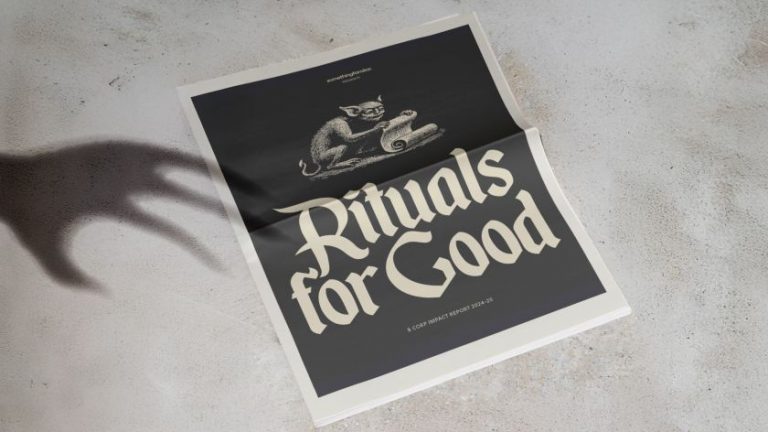Although Playmate exists in the world of sexual wellness, it goes against the explicit graphics and phrases typical of the category in favour of a brand that promotes meaningful connections between couples.
Sexual wellness is becoming less taboo by the day, with people of all ages, genders and orientations becoming more informed on the topic. The fact that the sector is growing can only mean good things when it comes to our relationships with our partners and ourselves, but there is one little problem.
When it comes to brands in this space, their visual and verbal identities haven’t quite caught up with increasingly progressive consumer outlooks. “It is quite a predictable marketplace, as you might imagine, where brands sit in more explicit or sleazy territories, and they’re often very product-focused,” says Unfound Studio creative director Jay Topham.
This was something that the studio’s team wanted to avoid when working on a recent project: a natural aphrodisiac chocolate brand called Playmate. Unfound was recommended to the founder by word of mouth, and they were intrigued from the beginning, though they immediately noticed that the initial branding ideas had to work harder if it was going to succeed.
Topham says: “The founder was ambitious; they told us they wanted the brand to be the new ‘Netflix and chill’, a little snippet from our early conversations that got us excited.
“The brief also explained that this was a growing sector, but that Playmate was more concerned with trends showing a growing physical and intimate disconnect between couples than libido-enhancing products.”
Some might say this is quite a niche sector for a design studio to work in; however, having recently worked with a women’s probiotic brand, an innovative collagen brand and a sex and relationship education platform, Unfound is no stranger to deconstructing taboos. Topham believes that a part of their role is “helping brands to find their point-of-view in complicated landscapes”.
With this in mind, Unfound focused on the idea of bringing couples closer together and forging better connections for the strategy phase rather than looking too much at the current sexual wellness marketplace. Topham says: “Difference drives our studio, so we knew if Playmate was to be memorable, it needed a more distinct point-of-view.”
Not only this, but if Playmate was going to achieve its goal of bringing couples closer together, Topham says, “it needed a more relatable and considered tone”, according to Topham.
Although it was a challenge, the studio sought to create a brand that guides people’s opinions from the first second. “This brand opinion affects everything, the mood, the colours, the copy”, he explains, adding that “too little or too much” will marginalise certain audiences, so the project was all about balance.
Playmate already had some branding in place, but it hadn’t yet been launched publicly. Topham recalls that one of the first and most important changes they made was to the logo, adding a question mark to position Playmate as “a proposition or a call to action”.
“To be as synonymous as something like ‘Netflix & chill’, we knew we needed the brand to become part of everyday language”, says Topham, and the question mark was a step in that direction.
The logotype – “a smooth sans-serif typeface that brings a playful edge to the brand” – was also changed to lowercase to soften the tone. Overall, the logo is simplistic but ownable and instantly recognisable.
Playmate’s wider type treatment was developed with flexibility in mind, making use of three different font styles. One is a hand-written type used for notes, adding a personal touch, while the sans-serif type is reserved for detail-orientated comms. The final serif type is used in most headlines and was chosen to add a premium feel to Playmate.
Deep shades of blue and red have been paired with soft beige, supported by classic black and white for the brand’s colour palette. “Our colours provide a luxurious feel to every touch-point while remaining both approachable and intimate,” says Topham.
Some of the stand-out graphic assets in this identity are the tokens, designed to reference romantic keepsakes, such as tickets, love letters or a restaurant bill. Topham explains how they showcase the Playmate personality, “reminding consumers of the intimate moments it can set up, no matter how small or big”.
He adds that it also helped to keep things “light, fun and suggestive”. On a functional level, they’re used across the identity to communicate headlines, elevate images and inform customers.
Early on, Unfound recognised that Playmate would be a social-first brand, so the photography referenced lo-fi content styles, used POV shot types, and leveraged multiple mediums, from point-and-shoot digital cameras to printed Polaroid and 35mm film.
Topham says, “Building a brand that will resonate with its audience means understanding where it will appear.
“The style was designed to feel relatable and easily replicated by couples, but also to land on a brand style that moved away from polished high-production campaigns to something more aligned to the user-generated content that prompts engagement and impact on social channels.”
Unfound also translated Playmate’s brand identity into a clever packaging system, centring around the idea of being ‘hidden in plain site’. Topham says the packaging was inspired by a conversation with Unfound designer Lauren Scarlett and copywriter Abbie, during which they discussed that you should not be embarrassed to have this brand on the bedside.
“Instead, it should be understated but desirable,” says Topham. He explains how the production process dictated the shape and size of the chocolates but that Unfound was able to create “a pull-out draw for an engaging unboxing experience”.
All of the product details – including the nutritional information – are kept inside the packaging on a little playing card (one of the brand tokens). The card includes lines like ‘anything but vanilla’ and ‘ingredients that let things flow naturally’.










